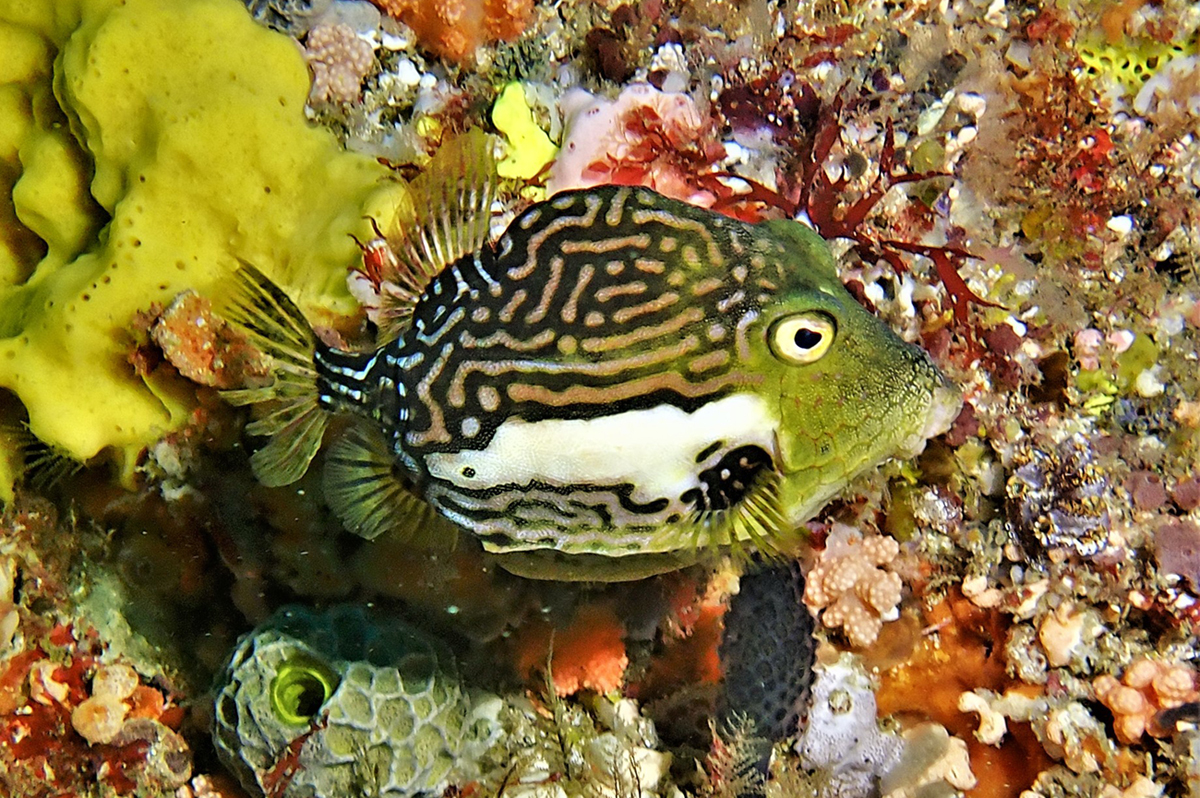Rigid Boxfish, Caprichthys gymnura McCulloch & Waite 1915
Other Names: Black-spotted Boxfish, Ornate Pigmy Boxfish

A Rigid Boxfish, Caprichthys gymnura, at the west end of Rottnest Island, Western Australia, March 2020. Source: J. Martin Crossley / iNaturalist.org. License: CC by Attribution-NonCommercial-ShareAlike
Summary:
Males are creamy white to yellowish tan with heavy dark wavy longitudinal lines and spots on the back, belly and caudal peduncle. Females are yellowish tan to creamy white with fine black spots along the side ridges near the bases of the spines.
Cite this page as:
Bray, D.J. 2023, Caprichthys gymnura in Fishes of Australia, accessed 10 Jul 2025, https://fishesofaustralia.net.au/Home/species/2473
Rigid Boxfish, Caprichthys gymnura McCulloch & Waite 1915
More Info
|
Distribution |
Southeast of Evans Island, Great Australian Bight, South Australia, to northwest of Kalbarri, Western Australia. Mostly inhabits deeper reefs and soft sediment areas on the continental shelf. Although mostly known from specimens taken as bycatch in commercial trawl fisheries, individuals have been recorded from tide pools along the southern coast of Western Australia, perhaps after being washed inshore during storms. |
|
Features |
Dorsal fin 12-13; Anal fin 12; Caudal fin 10-12; Pectoral fin 12. Body short, circular in profile, very deep, somewhat hexagonal in cross section; pronounced keel like ridges on dorsal and ventral midlines, especially dorsally; each side with distinct longitudinal ridges ventro-laterally and dorso-laterally with prominent flattened curved spine posteriorly; small flattened spine sometimes above each eye. Head moderately small, dorsal profile straight; eyes small, high on head, directed antero-aterally; mouth small, terminal, with fleshy lips; teeth long, curved, close set, single row in each jaw; gill opening on each side in form of short vertical slit just in front of pectoral fin base. Scales large, hexagonal, fused into rigid bony carapace, covering body in front of dorsal and anal fins, centre of each individual plate with very low tubercle and radiating rows of finer tubercles connecting adjoining plates; caudal peduncle sometimes with small bony plates, never forming complete bony ring. Single dorsal fin small, fan like, with short base, its length about equal to depth of caudal fin base, positioned posteriorly on body; anal fin identical to and opposite dorsal fin; caudal fin rounded. Pectoral fins small, fan like. Pelvic fins absent. |
|
Etymology |
The specific name gymnura is from the Greek gymnos (= bare, naked) and oura (= tail), in reference to the lack of bony plates encircling the rear of the caudal peduncle. |
|
Species Citation |
Caprichthys gymnura McCulloch & Waite, 1915, Trans. R. Soc. S. Aust. 24: 482, pl. 19. Type locality: Doubtful Island Bay, southwest Australia. |
|
Author |
Bray, D.J. 2023 |
|
Resources |
Rigid Boxfish, Caprichthys gymnura McCulloch & Waite 1915
References
Hoschke, A., Whisson, G. & Moore, G.I. 2019. Complete list of fishes from Rottnest Island. pp. 150-161, in Whisson, G. & Hoschke, A. (eds) The Rottnest Island fish book. 2nd ed. Perth, Western Australia.
Hutchins, J.B. & Swainston, R. 1986. Sea Fishes of Southern Australia. Complete field guide for anglers and divers. Perth : Swainston Publishing 180 pp.
Kuiter, R.H. 1994. Family Aracanidae. pp. 892-902, figs 788-794 in Gomon, M.F., Glover, C.J.M. & Kuiter, R.H. (eds). The Fishes of Australia's South Coast. Adelaide : State Printer 992 pp. 810 figs.
Matsuura, K. 2008. Families Ostraciidae, Tetraodontidae. pp. 842-856 in Gomon, M.F., Bray, D.J. & Kuiter, R.H. (eds). Fishes of Australia's Southern Coast. Sydney : Reed New Holland 928 pp.
Matsuura, K., Amaoka, K. & Carpenter, K.E. 2020. Caprichthys gymnura. The IUCN Red List of Threatened Species 2020: e.T162918261A162918284. https://dx.doi.org/10.2305/IUCN.UK.2020-1.RLTS.T162918261A162918284.en. Accessed on 16 June 2023.
May, J.L. & Maxwell, J.G.H. 1986. Field Guide to Trawl Fish from Temperate Waters of Australia. Hobart : CSIRO Division of Marine Research 492 pp.
McCulloch, A.R. & Waite, E.R. 1915. A revision of the genus Aracana and its allies. Transactions of the Royal Society of South Australia 39: 477-493 pls 16-25 See ref at BHL





